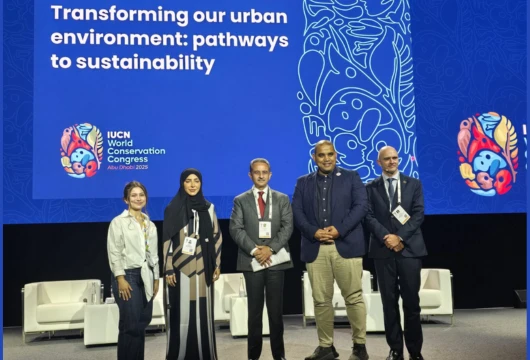India Leads Global Dialogue on Sustainable, Nature-Positive Urban Development
In a powerful statement of intent for the world’s urban future, India outlined its vision for sustainable urban development at the IUCN World Conservation Congress 2025 held in Abu Dhabi. Addressing the Ministerial Panel on “Transforming our Urban Environment: Pathways to Sustainability,” Union Minister of State for Environment, Forest and Climate Change, Shri Kirti Vardhan Singh articulated India’s comprehensive, people-centric, and nature-positive urban growth model that seeks to balance development with ecological preservation.
The Minister underscored that India’s approach to sustainability is anchored in Mission LiFE — the global movement launched by Prime Minister Shri Narendra Modi that inspires individuals and institutions to adopt lifestyle changes for the planet. “India’s urban vision places both people and the planet at its heart,” Shri Singh said, emphasizing that cities must evolve into engines of low-carbon, inclusive development.
India’s Urban Sustainability Blueprint
Shri Singh highlighted that India’s journey toward sustainable urban development is built upon three critical pillars — enabling frameworks, innovative financing, and capacity building. These pillars are driving the transformation of urban spaces into green, energy-efficient, and climate-resilient ecosystems.
- Enabling Frameworks and Standards:
India has developed green building codes, energy efficiency standards, and municipal finance frameworks that set the foundation for climate-friendly urbanisation. These standards not only improve livability but also guide cities in aligning infrastructure development with national sustainability goals. - Innovative Financing Models:
The government’s financial strategy focuses on central grants, viability-gap funding, and the promotion of green bonds to attract both public and private investments. By encouraging access to municipal bond markets, India is empowering cities to finance their own climate initiatives sustainably. - Capacity Building and Knowledge Sharing:
Through programmes such as the Smart Cities Mission and AMRUT (Atal Mission for Rejuvenation and Urban Transformation), India is investing in urban leadership, data systems, and training modules. These enable municipal bodies to plan, implement, and replicate model sustainability projects effectively.
Flagship Missions Powering the Transition
Shri Singh spotlighted India’s flagship programmes that are driving transformation across hundreds of cities:
- The Smart Cities Mission, covering 100 cities, integrates renewable energy, sustainable mobility, and data-driven governance. It has rolled out smart street lighting, rooftop solar installations, and building energy management systems that reduce emissions while enhancing quality of life.
- The Energy Conservation Act (Amended 2022) introduces strengthened energy-efficiency standards for buildings, appliances, and industries. Importantly, it enables the establishment of a domestic carbon-credit market, encouraging cities and businesses to lower their carbon footprint and earn incentives for sustainable practices.
- The AMRUT Programme supports municipalities in upgrading to energy-efficient water supply and pumping systems. This initiative has not only reduced operational costs but also helped local bodies cut down on energy consumption and greenhouse gas emissions.
Together, these programmes are creating a new urban paradigm — one where growth aligns with green goals, and innovation goes hand-in-hand with inclusion.
Urbanisation as a Catalyst for Climate Action
India’s message at the IUCN Congress was clear: urbanisation is not the enemy of the environment — it can be the engine of sustainability. Shri Singh noted that with the right mix of vision, finance, and citizen engagement, cities can become hubs of low-carbon innovation and climate resilience.
“Urbanisation, when managed with foresight and inclusion, becomes a powerful lever for achieving climate goals,” he said. India’s integrated policy approach, which combines national-level strategy with local-level execution, ensures that climate-friendly infrastructure development becomes a default practice across cities.
The government’s emphasis on compact, transit-oriented, and energy-efficient urban growth reflects this shift in thinking. Cities are being encouraged to prioritise public transport, mixed land use, and sustainable architecture to reduce congestion, pollution, and energy demand.
The Role of Policy and Partnerships
Shri Singh emphasised that national governments must provide stable policy frameworks that allow cities to update their bylaws, strengthen their development codes, and access climate finance. The Ministry of Environment, Forest and Climate Change (MoEFCC) is fostering such frameworks through cross-sectoral collaboration with ministries of housing, power, and transport.
He also called for deeper technology partnerships and international cooperation to share best practices in urban sustainability. “Collaboration is key — between governments, industry, and citizens — if we are to create cities that are livable, green, and inclusive,” Shri Singh remarked.
India’s Global Leadership on Sustainability
India’s participation at the IUCN World Conservation Congress underscores its leadership role in shaping the global sustainability agenda. The country’s urban transformation is being closely watched as a replicable model for the Global South — a region that faces the dual challenge of rapid urbanisation and climate vulnerability.
Through Mission LiFE, India is mobilising citizens worldwide to adopt sustainable habits. The Smart Cities Mission and AMRUT demonstrate how national policies can translate into local climate action. Meanwhile, India’s investments in renewable energy, carbon markets, and circular economy frameworks are laying the groundwork for long-term resilience.
The Minister’s address was a reaffirmation that India’s urban growth story is not just about infrastructure, but about inclusivity, innovation, and integrity — ensuring that the benefits of development reach every citizen without compromising environmental balance.
A Vision for the Future
As Shri Kirti Vardhan Singh concluded, he called upon nations of the Global South to join forces in building cities that are both aspirational and compassionate. “Our goal must be to create urban spaces where aspirations can thrive without losing the human touch,” he said.
India’s roadmap for sustainable urban development—anchored in strong policies, inclusive planning, and citizen participation—serves as a blueprint for the world. It shows that the journey toward climate-resilient, nature-positive urban futures is not only possible but also essential for human progress.
With its ambitious targets, integrated missions, and focus on innovation, India is steadily transforming its cities into beacons of sustainability — demonstrating that growth and green goals can indeed go hand in hand.
For more in-depth analysis and inspiring climate news, click here

